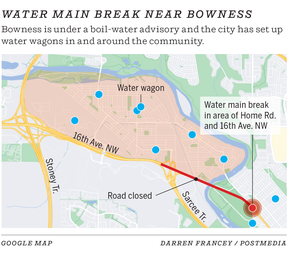The last such water main break happened in 2004 — though that pipe was about half the size of the one that ruptured Wednesday night

Article content
It will likely take at least a week to repair the catastrophic water main break that occurred Wednesday night in northwest Calgary, says the engineer who spent 42 years responsible for Calgary’s water infrastructure.
“Based on what I’ve seen out there, you’re talking a minimum of a week,” James Buker said of the repairs needed on the feeder line in the northwest community of Montgomery. Buker was a transmission and distribution engineer for the City of Calgary’s division formerly known as waterworks from 1975 to 2016.
Advertisement 2
Article content
Calgarians will likely remain under Stage 4 water restrictions until those repairs are completed, he said.
“This is the biggest (pipe) I’ve ever seen fail catastrophically,” he said.
Questions about the state of the feeder line before the break have been rampant since Wednesday evening. Buker witnessed the city install the pipe in 1975 at the exact location where it ruptured. The pipe, made with a combination of precast concrete, steel cylinder and wires spun to create tension, is standard for water mains of that size, both in the 1970s and in the 2020s, he said.
The 11-kilometre feeder main is a major artery that supplies water to Calgary from the Bearspaw Water Treatment Plant, one of Calgary’s two major water sources alongside the Glenmore Reservoir. Workers were still pumping out water from the pipe Friday afternoon. The city has been unable so far to fully understand the damage and will finalize its repair plans once it understands the full extent of the damage, officials said in an afternoon update.

Over time, freeze-thaw cycles, fluctuating water tables and soils containing certain chemicals can deteriorate the concrete around the steel wires and cylinder, Buker said. “When that happens, that stuff corrodes and it’s just a matter of time before it explodes.”
Article content
Advertisement 3
Article content
The most common age of failure for water mains made with precast concrete, especially those under high pressure, is around 50 years — the age Calgary’s broken main was just about to reach, said Tricia Stadnyk, professor and Canada Research Chair in hydrologic modelling with the University of Calgary’s Schulich School of Engineering. Stadnyk also said the week-minimum repair time for the main is a highly likely outcome.
The city did routine maintenance work on the feeder main earlier this spring, said Nancy Mackay, Calgary’s director of water services. The city still hasn’t determined what caused the break.
“We actually had done some work on this one — because it’s such a critical one, that’s part of our due diligence is making sure that we’ve got good backup plans for when something goes wrong,” Mackay said Thursday.
Stadnyk said she has little doubt the pipe had been flagged by city engineers and that requests for funding and upgrades had been made. “What city council wants to pay for that and go through the hassle with the citizens and be responsible for that when it’s out of sight, out of mind?” she said.
Advertisement 4
Article content

The most recent break of similar magnitude occurred on a frigid day in January 2004 when a water main on McKnight Boulevard broke, leaving more than 100,000 Calgarians deprived of service for several hours.
But that pipe — which spewed enough water to almost fully submerge two cars and forced crews to rescue a pair of motorists by boat — was about half the size of the one currently broken in Montgomery, Buker said. The incident affected residents as far out as Canmore, who were asked to reduce their water usage.
Repairs to rectify that incident took nearly three weeks, according to Calgary Herald archives. Some Calgarians resorted to melting snow to fill their toilets, said a Jan. 26, 2004, story in the Herald.
In the intervening years, the city has kept in storage several two-metre-long feeder pipes that can be used to replace old ones, Buker said. “That’s a huge salvation — that’s probably going to save them a week or two of time right there.”
Although significant amounts of water have been lost in recent days, Buker said he believes improvements to Calgary’s water levels due to significant rain over the past month won’t be lost once the line is repaired.
Advertisement 5
Article content
Stadnyk, however, said the current strain on Calgary’s water systems could end up hurting once again later in the summer if not enough rain falls.
“If the rains don’t continue, then this coupled with the drought is going to put us into a precarious position come the end of summer and early fall,” Stadnyk said. “This was really the last thing we needed.”
City hall’s warnings that Calgary could run out of water are legitimate, she said.
“If we don’t cut back our water use, then simply you’re going to turn on your tap and nothing’s going to come out. That’s just the way it is.”
Article content



